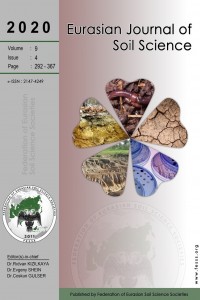Abstract
References
- Alavi, N., Nozari, V., Mazloumzadeh, S.M., Nezamabadi-pour, H., 2010. Irrigation Water quality evaluation using adaptive network-based fuzzy inference system. Paddy and Water Environment 8: 259-266.
- Cemek, B., Ünlükara, A., Kurunç, A., Küçüktopcu, E., 2020. Leaf area modeling of bell pepper (Capsicum annuum L.) grown under different stress conditions by soft computing approaches. Computers and Electronics in Agriculture 174: 105514.
- Eaton, F.M., 1950. Significance of carbonates in irrigation waters. Soil Science 69(2): 123–134.
- Küçüktopcu, E., Cemek, B., 2020. The use of artificial neural networks to estimate optimum insulation thickness, energy savings, and carbon dioxide emissions. Environmental Progress & Sustainable Energy e13478.
- Laluraj, C.M., Gopinath, G., 2006. Assessment on seasonal variation of groundwater quality of Phreatic aquifers – A river basin system. Environmental Monitoring and Assessment 117: 45-57.
- McKone, T.E., Deshpande, A.W., 2005. Can fuzzy logic bring complex problems into focus? Modeling Imprecise Factors in Environmental Policy. Journal of Environmental Science and Technology 39(2): 42A-47A.
- McNeil, F.M., Thro, E., 1994. Fuzzy Logic: A Practical Approach. AcademicPress, Boston MA, USA. 350p.
- Mirabbasi, R., Mazloumzadeh, S.M., Rahnama, M.B., 2008. Evaluation of irrigation water quality using fuzzy logic. Research Journal of Environmental Sciences 2(5): 340-352.
- Priya, K.L., Arulraj, G.P., 2011. A correlation-regression model for the physicochemical parameters of the groundwater in Coimbatore city, India. Environmental Technology 32(7): 731-738.
- Richard, L.A., 1954. Diagnosis and improvement of saline and alkali soils. Agriculture Handbook Vol. 60. United States Department of Agriculture, Washington, DC, USA. 160p.
- Taylor, K.E., 2001. Summarizing multiple aspects of model performance in a single diagram. Journal of Geophysical Research: Atmospheres 106(D7): 7183-7192.
- Vadiati, M., Nalley, D., Adamowski, J., Nakhaei, M., Asghari-Moghaddam, A., 2019. A comparative study of fuzzy logic-based models for groundwater quality evaluation based on irrigation indices. Journal of Water and Land Development 43(1): 158-170.
- Wilcox, L.V., 1955. Classification and use of irrigation waters. Circ. No. 969. US Dept Agriculture, Washington DC, 19p. Available at [Access date: 25.05.2019]: https://www.ars.usda.gov/arsuserfiles/20360500/pdf_pubs/P0192.pdf
Evaluation of quality of groundwater in irrigation using fuzzy logic in the Bafra Plain, Northern Turkey
Abstract
The quality of groundwater plays an important role in irrigation management and planning. The most commonly used method when classifying the irrigation water quality is the United States Soil Laboratory (USSL) diagram. Fuzzy logic approach is one of the widely used methods produced more precise and accurate results according to the USSL diagram. A rule-based, fuzzy logic irrigation water quality (FL-IWQ) were evaluated by using electrical conductivity (EC), sodium adsorption ratio (SAR), and residual sodium carbonate (RSC) values of groundwater in irrigation, in Bafra plain. The FL-IWQ defuzzification methods-center of area (COA), mean of maxima (MOM), least of maxima (LOM), and (SOM) were selected and compared with quality values of groundwater in irrigation. Based on the results of the FL-IWQ defuzzification methods with quality values of groundwater in irrigation, the determination of coefficients for COA, MOM, SOM and LOM were 0.9874, 0.9755, 0,9574 and 0.9453, respectively. Results obtained from FL-IWQ revealed that there has been 93% general agreement with the results obtained from the USSL diagram and RSC classification. The developed fuzzy model produced more reliable results for groundwater in irrigation than that of the USSL-diagram and RSC classification. The study suggests using proposed fuzzy model as a promising alternative to the traditional ones for classifying the quality of groundwater in irrigation under uncertain conditions.
Keywords
References
- Alavi, N., Nozari, V., Mazloumzadeh, S.M., Nezamabadi-pour, H., 2010. Irrigation Water quality evaluation using adaptive network-based fuzzy inference system. Paddy and Water Environment 8: 259-266.
- Cemek, B., Ünlükara, A., Kurunç, A., Küçüktopcu, E., 2020. Leaf area modeling of bell pepper (Capsicum annuum L.) grown under different stress conditions by soft computing approaches. Computers and Electronics in Agriculture 174: 105514.
- Eaton, F.M., 1950. Significance of carbonates in irrigation waters. Soil Science 69(2): 123–134.
- Küçüktopcu, E., Cemek, B., 2020. The use of artificial neural networks to estimate optimum insulation thickness, energy savings, and carbon dioxide emissions. Environmental Progress & Sustainable Energy e13478.
- Laluraj, C.M., Gopinath, G., 2006. Assessment on seasonal variation of groundwater quality of Phreatic aquifers – A river basin system. Environmental Monitoring and Assessment 117: 45-57.
- McKone, T.E., Deshpande, A.W., 2005. Can fuzzy logic bring complex problems into focus? Modeling Imprecise Factors in Environmental Policy. Journal of Environmental Science and Technology 39(2): 42A-47A.
- McNeil, F.M., Thro, E., 1994. Fuzzy Logic: A Practical Approach. AcademicPress, Boston MA, USA. 350p.
- Mirabbasi, R., Mazloumzadeh, S.M., Rahnama, M.B., 2008. Evaluation of irrigation water quality using fuzzy logic. Research Journal of Environmental Sciences 2(5): 340-352.
- Priya, K.L., Arulraj, G.P., 2011. A correlation-regression model for the physicochemical parameters of the groundwater in Coimbatore city, India. Environmental Technology 32(7): 731-738.
- Richard, L.A., 1954. Diagnosis and improvement of saline and alkali soils. Agriculture Handbook Vol. 60. United States Department of Agriculture, Washington, DC, USA. 160p.
- Taylor, K.E., 2001. Summarizing multiple aspects of model performance in a single diagram. Journal of Geophysical Research: Atmospheres 106(D7): 7183-7192.
- Vadiati, M., Nalley, D., Adamowski, J., Nakhaei, M., Asghari-Moghaddam, A., 2019. A comparative study of fuzzy logic-based models for groundwater quality evaluation based on irrigation indices. Journal of Water and Land Development 43(1): 158-170.
- Wilcox, L.V., 1955. Classification and use of irrigation waters. Circ. No. 969. US Dept Agriculture, Washington DC, 19p. Available at [Access date: 25.05.2019]: https://www.ars.usda.gov/arsuserfiles/20360500/pdf_pubs/P0192.pdf
Details
| Primary Language | English |
|---|---|
| Journal Section | Articles |
| Authors | |
| Publication Date | October 1, 2020 |
| Published in Issue | Year 2020 Volume: 9 Issue: 4 |


